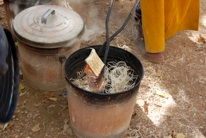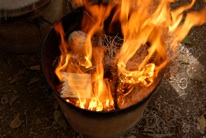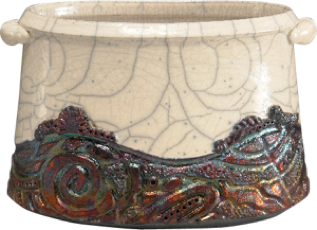Bridget Donahue Pottery bridget@bridgetdonahue.com

The process of Raku firing differs from other firing methods because the pots are removed from the kiln at their maximum temperature.
Raku glazes are often fractured, referred to as crazing. These crackle glazes are enhanced by the post firing smoking of Raku pots that embeds carbon into the crackles of the glaze (above).
Raku was developed in Japan in the 16th century, not becoming popular in the United States until the 1970s.
Pots are heated to 1800 degrees F, the kiln is opened and each molten glazed pot is removed with a pair of tongs.(pictured upper right)
The extremely hot pots are placed into containers of sawdust, leaves, paper, or some type of combustible, which produces thick black smoke or small particles of carbon. Because the container is sealed, all of the oxygen is burned up and the container becomes pressurized. This allows the carbon to be wicked into the porous clay body, blackening the clay and accentuating the crackle pattern of the glaze. This carbon also reacts with the copper carbonate/oxide in the the glazes to produce a wonderful rainbow of colors (above).
Because of the porous aspect of the clay body and crazing of the glazes, Raku pots are not watertight, therefore not food safe.
Work available at these shows and galleries:
Raku Firing

This work is currently unavailable



